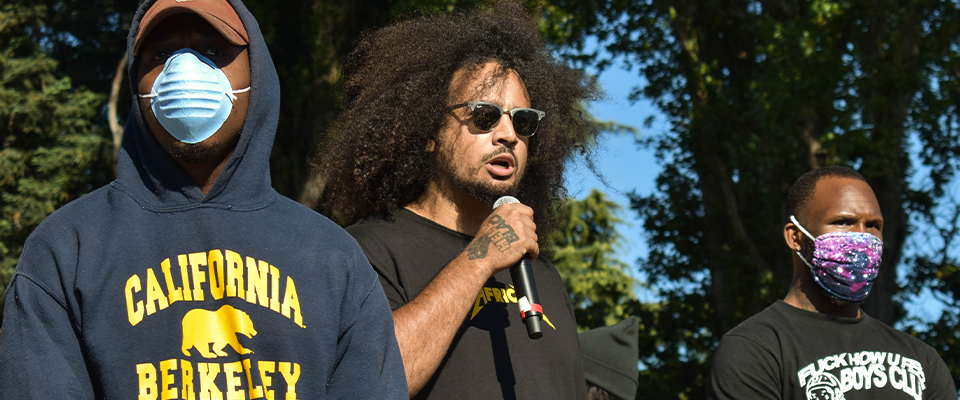DR. HANNAH ZEAVIN’S WORK explores the question of how we recover from trauma, and the roles that technology and media play in how we understand each other and ourselves. She is a lecturer in the English and History departments at UC Berkeley and an affiliate of Berkeley’s Center for Science, Technology, Medicine and Society, and sits on the executive committee for Berkeley’s Center for New Media.

Her book, The Distance Cure: A History of Teletherapy (MIT Press, August), is a broad examination of remote talk therapy. It traces the practice from its earliest iterations; letter writing, advice columns, and support hotlines, to today’s computer programs and apps. Dr. Zeavin says that while teletherapy “has long been escorted by a democratizing promise,” the reality has been more complicated.
In keeping with the theme, California spoke to Zeavin remotely on Zoom about how the last year has impacted her work, the online mental health care, and how the pandemic has impacted the way we think about distance.
This interview has been edited for length and clarity.
Can you tell me a little bit more about the earliest iterations of teletherapy?
The case I start with is Freud himself. Freud, it is well known, made much hay of new media in his moment. He was deeply invested in futzing with how therapy could work, as he was elaborating a very rigorous way of doing mental health care. And one of the experiments was, of course, on himself.
In psychoanalysis, part of becoming an analyst is being analyzed. So what are you going to do if you’re the father of psychoanalysis? Freud’s answer was something called a self analysis, which was recorded in a series of letters to his best friend. And I argue in this book, it’s not a self analysis. It’s the first tele analysis. Then Freud later worked via letter with many people, and had a full blown analysis with a five year old boy who was agoraphobic. He wouldn’t leave the house, and the father was a student of Freud’s. So the father, Freud, and the little boy all worked together via post, and it helped.
I didn’t realize Freud practiced teletherapy.
Why have we ignored this when the moral panic around teletherapy is so much about “Freud would never…”? What happens if we take [teletherapy] out of that binary of good and bad, and loss and richness, and think about it in its own terms?
You mentioned a long activist history of teletherapy in the Bay Area, can you tell me more about that?
“We don’t think of the suicide hotline as teletherapy, but it is. And it’s free, and so it invites the possibility for radical and moving care.”
In general, we don’t think of [the suicide hotline] as teletherapy, but of course it is. But also, it becomes anonymous, and it’s free, and so it invites the possibility for radical and moving care.
The suicide hotline was first pioneered by a man named Chad Varah, who was an Anglican priest who saw that so many of the mental health crises that were presenting themselves in his parish had to do with taboo, and the questions that people couldn’t ask and the things they couldn’t speak—not even in a confessional. He realized that they really needed the protective qualities of anonymity and distance to say anything.
In London, there was a major spike in suicides right after the end of World War II. So he moved his parish to an empty rectory in London—it was empty because the church itself had been bombed during the Blitz—and he and his secretary started a hotline, a telephone number that you can just dial. [It] immediately took off, and more and more people wanted to call in.
That hotline is now the Samaritans, the largest organization for suicide prevention in the world.
In the United States, when the hotline got imported—the first one in the actual spirit of the hotline, not like a priest with a phone that you could call in—was in the Bay Area, in the late 50s, early 60s, run by Bernard (Bruce) Mayes. He advertised his hotline on the inside flap of matchbooks with this sort of ominous message, “Thinking of ending it all? Call Bruce.” And Bruce sends a kind of dog whistle that it was a queer friendly and queer-run hotline. And because this was the moment of the Lavender Scare and endless raids on the gay bars of San Francisco, he advertised in the gay bars around the Tenderloin neighborhood.
At the time, San Francisco had the highest per capita suicide rate in the world outside of West Berlin. Mayes wouldn’t allow anyone who was actually a trained social worker or psychiatrists to work the hotline, though many volunteered, because he believed those disciplines carried with them such intense judgment, both about queerness, about race and gender, and also that suicide was bad.
Mayes didn’t feel this way. He wanted to help people who wanted to be helped, but not punish or criminalize those who didn’t want help, and that was what the service was for.
So he starts this hotline, and the suicide rate in San Francisco per capita cuts in half within one year.
Can you tell me more about the moral panic around teletherapy? Is it unfounded, or is there a reason for concern?
There have been moments in the history of teletherapy, where care has been deep and accessible, but it’s not happening on stuff you can download from the App Store.”
It’s both. And the argument of the book is neither techno-optimistic, nor is it invested in this narrative that teletherapy is inherently lesser or worse. It’s more complicated than that. The focus right now is on corporate apps that are bad for workers and patients alike. And some of those problems have to do with a lack of any systematized form of mental health care in this country.
The sort of moral panic around teletherapy is like any moral panic around technology: that it’s ruining our most intimate relationships, that it is only a loss, and that it needs to be stopped at all costs. A lot of these apps are not supplying care that is either deep, nor is it for people who otherwise wouldn’t receive treatment. The people who evangelize contemporary teletherapy argue that they do those things, but they don’t. That doesn’t mean no one’s ever had a successful interaction. And it doesn’t mean that some therapists don’t love it. But by and large, that’s not happening.
But what my book tries to do is say that despite all that contemporary evangelizing, there have been moments in the history of teletherapy, where care has been deep and accessible, but it’s not happening now. And it’s not happening on stuff you can download from the App Store.
You said that we can learn a lot from the ad hoc nature of these early iterations of teletherapy. It seems like in the last year we’ve been in another kind of an ad hoc moment. Are there parallels that you see?
One of the parallels is that there is this crisis around access and money again. When Freud was operating after World War I, everyone could make use of some mental health care. The Spanish flu pandemic was also happening, to which Freud lost Sophie, his beloved eldest daughter. Think about the legion of men who served in World War I, let alone the people on the home front who were also destroyed by not only loss, but by battle. So in that moment there was this real pressure to think about how, if everyone needed care, it couldn’t just be for very few.
“It’s not so much about saying this is better, and this is worse. It’s about saying we have to answer the deeper crisis, which is a lack of care.”
We can also learn from history that it’s not so much about saying this is better, and this is worse. It’s about saying we have to answer the deeper crisis, which is a lack of care. From there, we have to make sure not to just offer the weakest interventions to the people who need it most, which I think is so often, ‘let’s just give them something as opposed to something good.’ And often the people who need it most are already the most vulnerable and least cared for in our society.
What concerns do you have about the corporatization of teletherapy?
The problem is Silicon Valley has stepped in and tried to capitalize on the promise [of increasing access]. But instead of it being about access, it’s more about efficacy. There is this push to batch process patients, which helps with access, except your practitioner is seeing four times the amount of clients they’re supposed to because they’re essentially on an Uber for therapy app. And this is a real shift in values. Teletherapy in that corporate space is often where we get a slippage from therapy to things like coaching or wellness, which is not therapy and is not regulated. That is the current state of these big corporate moves into teletherapy.
But some things can come from not being in the room together. And I think that’s been a stunning lesson of the pandemic—for some patients and clinicians, this does not work that well. But for other people, it really does. A central claim of the book is to remind readers that distance is not the opposite of presence, absence is.
It would be really disappointing if teletherapy became only synonymous with corporate apps.
How should we evaluate or quantify the efficacy of teletherapy? Are there metrics that people should keep an eye out for?
Yeah, and this is a whole kettle of fish. Efficacy in therapy in general is really hard, because talk therapy hasn’t been as interested in that kind of research as many other fields of scientific study. With teletherapy, there’s also this whole additional problem, which is that if an app is trying to prove its effectiveness, they get to say what they mean by effective. It’d be very hard for the layperson to do all the work of looking at the psychological studies, and that’s why these apps are so persuasive. In their relentless marketing they promise efficacy and friction-free care. And again, that friction-freeness may be part of the problem.
What advice do you have for people struggling to access mental health care, either for financial reasons or because they can’t find an appropriate provider?
It can be really hard to find care. Part of that is because where Silicon Valley has disrupted, it’s not in connecting patients to practitioners, it’s running through a proprietary app. Sometimes they’re not even therapy apps. Sometimes they’re coaching and wellness initiatives, often from employers. And employers do this thing where they collapse productivity and wellness, such that the question of mental health is actually about returning the employee to productivity, not to a deeper, richer idea of mental health or well-being. It’s just like, get on the Calm App. That style of “disrupting mental healthcare,” why it’s so compelling is because there is no workable system. So in fact, they didn’t have to do very much to disrupt it.
Therapy is hard work. So of course, teletherapy is deeply compelling. And sometimes it’s the only thing on offer. The question is, and this is an open question, is any help better than no help at all? Or is only good help better than no help at all? And we can have that debate.
Daniel Lempres is a freelance reporter and an alum of the UC Berkeley School of Journalism.





















